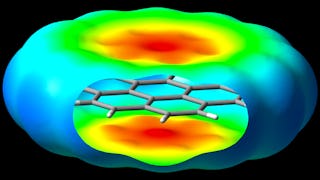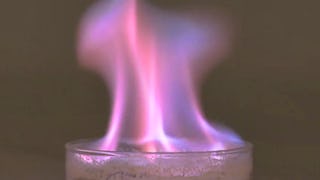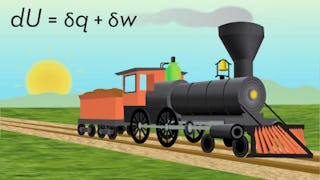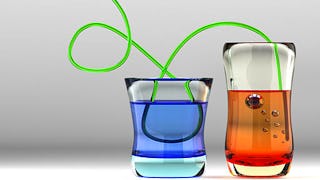The course introduces the three key spectroscopic methods used by chemists and biochemists to analyse the molecular and electronic structure of atoms and molecules. These are UV/Visible , Infra-red (IR) and Nuclear Magnetic Resonance (NMR) spectroscopies. The content is presented using short focussed and interactive screencast presentations accompanied by formative quizzes to probe understanding of the key concepts presented. Numerous exercises are provided to facilitate mastery of each topic. A unique virtual spectroscopic laboratory is made available to enable students to measure and analyse spectra online. Assessment is via summative quizzes completed during the course period.

3 days left: Get a Black Friday boost with $160 off 10,000+ programs. Save now.


Introduction to Molecular Spectroscopy

Instructor: Patrick J O'Malley, D.Sc
69,781 already enrolled
Included with
(2,629 reviews)
Skills you'll gain
Details to know

Add to your LinkedIn profile
7 assignments
See how employees at top companies are mastering in-demand skills

There are 4 modules in this course
In this first week we introduce the electromagnetic spectrum and the origin of transitions giving rise to ultraviolet and visible (UV/Vis) spectra. You will learn that electronic transitions are caused by absorption of radiation in the UV/Vis region of the electromagnetic spectrum. The reason for the wavelength and intensity of bands will be described and the colour origin of certain compounds will be discussed. You will also be shown how UV/Vis spectroscopy is performed and you will be able to run and analyse your own spectra. As the final activity in this module you are given a link to view how to obtain a UV/Visible spectrum in the laboratory. Good luck, try and participate in the discussion forums to enhance your learning and don't forget to complete the end of week laboratory quiz which contributes to your final mark.
What's included
10 videos7 readings2 assignments
In this module we introduce the theory underpinning infrared (IR) spectroscopy and show examples of analysis using the technique. Transitions between the vibrational energy levels of molecules occurs in the infrared region of the electromagnetic spectrum. We start with the theory underlying vibration using the simple harmonic oscillator model. Analysis of more complex molecules is introduced using group frequencies and number of vibrational modes. You will also be shown how to obtain an infrared spectrum and will have an opportunity to run your own spectrum. At the end of this module you are given a link to view how to obtain an infra red spectrum in the laboratory. Don't forget to complete the end of week laboratory quiz which contributes to your final mark for this course.
What's included
6 videos4 readings2 assignments
This week we concentrate on Nuclear Magnetic Resonance (NMR) spectroscopy. Here a magnetic field is used to create energy levels for magnetic nuclei present in a molecule. Transition between these energy levels occurs in the radiofrequency region of the electromagnetic spectrum. The positions of the bands in the observed spectrum is dependent on the shielding of the nuclei by the local electronic structure, giving rise to a parameter known as chemical shift. Bands also display fine structure caused by spin-spin coupling with neighbouring nuclei. Examples on the analysis of NMR spectra for structure determination will be given. As the final activity in this module you are given a link to view how to obtain an NMR spectrum in the laboratory. Don't forget to compete this end of week laboratory quiz which contributes to your final mark.
What's included
9 videos4 readings2 assignments
What's included
1 assignment
Instructor

Offered by
Explore more from Chemistry
 Status: Preview
Status: PreviewUniversity of Manchester
 Status: Preview
Status: PreviewDuke University
 Status: Preview
Status: PreviewUniversity of Minnesota
 Status: Preview
Status: PreviewDuke University
Why people choose Coursera for their career




Learner reviews
2,629 reviews
- 5 stars
76.65%
- 4 stars
18.59%
- 3 stars
3.61%
- 2 stars
0.76%
- 1 star
0.38%
Showing 3 of 2629
Reviewed on Oct 25, 2017
Some of the questions had wrong answers in the system and hence the actual marks shown is not reflective of the exam. Please see to it that the system has correct answers.
Reviewed on May 7, 2020
It was a good experience to learn online. This course increase my knowledge an i gain new concept which are very helpful for me and guide me in this field more. THANK YOU VERY MUCH TO COURSERA.
Reviewed on Oct 14, 2020
This course helped me to further understand the principle behinds the 3 main spectroscopic techniques: UV/VIS, IR and NMR which is very beneficial for my future career working in a lab environment.

Open new doors with Coursera Plus
Unlimited access to 10,000+ world-class courses, hands-on projects, and job-ready certificate programs - all included in your subscription
Advance your career with an online degree
Earn a degree from world-class universities - 100% online
Join over 3,400 global companies that choose Coursera for Business
Upskill your employees to excel in the digital economy
Frequently asked questions
To access the course materials, assignments and to earn a Certificate, you will need to purchase the Certificate experience when you enroll in a course. You can try a Free Trial instead, or apply for Financial Aid. The course may offer 'Full Course, No Certificate' instead. This option lets you see all course materials, submit required assessments, and get a final grade. This also means that you will not be able to purchase a Certificate experience.
When you purchase a Certificate you get access to all course materials, including graded assignments. Upon completing the course, your electronic Certificate will be added to your Accomplishments page - from there, you can print your Certificate or add it to your LinkedIn profile.
Yes. In select learning programs, you can apply for financial aid or a scholarship if you can’t afford the enrollment fee. If fin aid or scholarship is available for your learning program selection, you’ll find a link to apply on the description page.
More questions
Financial aid available,

